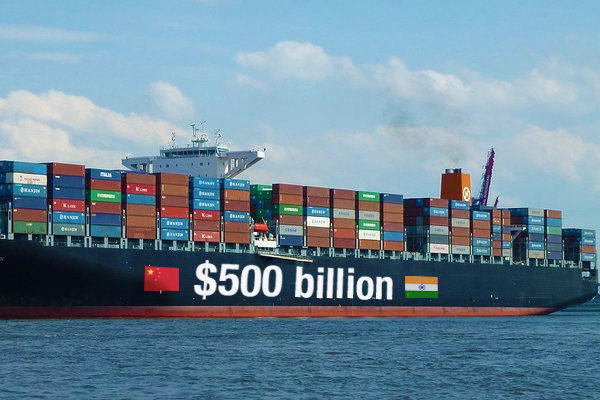How China-India Trade can Rise to $500 Billion

By Professor of Entrepreneurship S. Ramakrishna Velamuri
As the Chinese Embassy in Delhi recently pointed out, China and India have made remarkable progress in the last 15 years, as bilateral trade has grown by a factor of 24 from $2.9 billion to $71.6 billion in 2015. This progress needs to be acknowledged and celebrated. However, the potential is higher still. Both countries should aim for $500 billion in bilateral trade within 10 years, which would require an annual growth rate of more than 20 percent.
This is feasible for three reasons. First, combined GDP was $12.94 trillion in 2015, roughly two-thirds of the US and Canada’s combined $19.5 trillion. The US and Canada had $759 billion in bilateral trade and $698 billion in bilateral investment stock in 2014, leading to an estimated 9 million jobs in the US alone. Second, India and China are neighbors, and there is plenty of research that shows bordering countries trade more with each other than distant countries. Third, each country’s exports with the other currently represent only about 3 percent of total exports.
In 2015, China’s exports to India were nearly seven times those from India to China. It is going to be difficult to significantly grow bilateral trade if the current imbalance is maintained. A more equitable partnership needs to be worked out. India has one of the youngest populations in the world (the median age is 27 years, approximately 10 years lower than in China) and needs to create jobs for the millions of youngsters joining its workforce every year. There are three ways in which China can contribute to this pressing need.
First, China could provide better market access in sectors where India is competitive. As the largest exporter of generic formulations in the world ($13 billion in 2015, with more than 50 percent coming from regulated markets and accounting for 30 percent of the US generics market by volume), and with approximately 200 US FDA approved manufacturing plants, India could make pharmaceutical products more affordable in China. China’s registration process for generic formulations and the bottlenecks in the issuance of bio-equivalence certifications need to be resolved. The barriers are not India-specific, but India is the biggest loser as it is the largest generic drugs exporter in the world. Information technology services is another area of strength for India, which exports nearly $100 billion in IT services mainly to the US, Western Europe and Japan, and accounts for more than 60 percent of the global outsourced offshoring market. Indian IT firms, partnering with large State-owned enterprises and private Chinese firms, could enhance the competitiveness of Chinese firms going global and create significant employment for university graduates in China, as the delivery centers for servicing the Chinese market would be staffed by Chinese IT engineers. Textiles, where India is the second largest exporter behind China, media and entertainment, healthcare services and tourism are other areas worth exploring.
Second, Chinese firms investing in India could ensure that a higher share of value addition takes place in India. Currently, China supplies high-value finished products, such as power generation, telecommunications equipment and mobile phones. Although several Chinese companies in these sectors have plans to invest in India, none have yet set up significant production facilities. If China could export components and ensure at least 40-50 percent value-addition in India through local sourcing and the employment of Indian workers, this would go a long way towards addressing both the trade imbalance as well as India’s need to create jobs. This would also increase the legitimacy of Chinese companies in India and enhance their brand value.
Third, greater and more equitable economic integration could eventually lead to a free trade agreement between the two countries. If this happens, companies such as Ford, GM, Geely and Tata might benefit from regional production strategies, which are widespread in the automobile industry in Europe and North America. This can lead to significant scale economies for the producers. Thus, GM might decide to specialize its Indian plants in smaller vehicles and its Chinese plants in mid-sized and larger vehicles. Vehicles from all the plants would be sold in both markets. Such integrated production strategies would also be attractive in other industries.
China would also benefit from a more balanced trade relationship. Over the next 10 years India plans to spend $1.5 trillion in infrastructure projects – such as, power generation, telecommunications, railway locomotives and coaches and urban mass transport systems – an area where China is very strong. These are precisely the high value-added sectors that China wants to emphasize in its economic transition. A win-win partnership will make the pie bigger for both countries, driving economic growth and job creation.
This article was first published by The Global Times.













